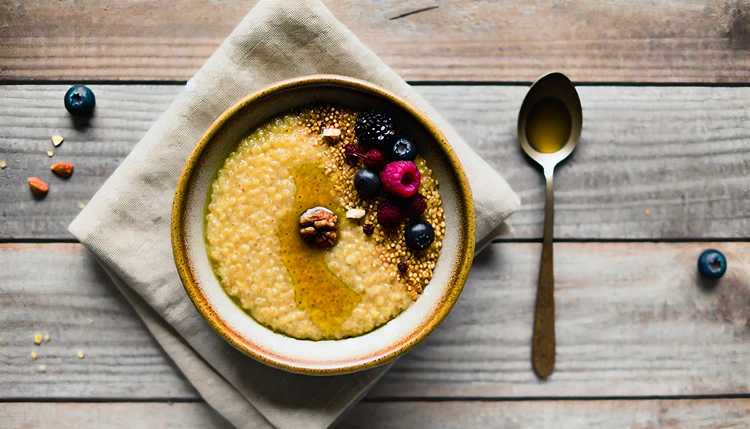Amaranth was a cornerstone of the Aztec diet, and it’s no wonder why. This tiny, nutrient-packed grain not only fueled warriors but also provided essential vitamins and minerals. But today, amaranth is often overlooked in favor of more well-known grains. So, what exactly makes amaranth such a nutritional powerhouse, especially when it comes to the Aztec diet?
The health benefits of amaranth in the Aztec diet are impressive. From being a source of plant-based protein to boosting heart health, this ancient grain continues to offer numerous advantages. Let’s explore what amaranth can do for your health and why it deserves a place on your table.
What Is Amaranth?

Amaranth is an ancient grain that has been cultivated for thousands of years. While not technically a true grain, its seeds resemble grains like quinoa or millet. In the Aztec diet, amaranth was considered a sacred crop, playing a significant role in both daily meals and religious ceremonies. Known as “huāuhtli” in the Aztec language, it was more than just a source of food—it was a symbol of life and sustenance.
Is Amaranth Gluten-Free?
Yes, amaranth is naturally gluten-free. This makes it an excellent option for people with celiac disease or those who follow a gluten-free diet. While the Aztecs didn’t have the gluten concerns that we do today, this aspect of amaranth still makes it a versatile and inclusive ingredient for modern diets.
Helpful Hint:
If you’re new to gluten-free grains, try incorporating amaranth into your morning porridge or baked goods. Its nutty flavor adds a unique twist to any recipe, and it pairs well with sweet and savory dishes.
How Amaranth Boosts Protein Intake
One of the biggest health benefits of amaranth in the Aztec diet is its protein content. Amaranth is a complete protein, meaning it contains all nine essential amino acids. For a plant-based food, this is pretty remarkable, as most grains lack one or more of these vital amino acids.
The Aztecs relied on amaranth to meet their protein needs, especially since their diet was primarily plant-based. In fact, amaranth contains about 14% protein, making it a valuable source of nutrition in an era where access to animal protein was more limited.
How Much Protein Does Amaranth Provide?
A single cup of cooked amaranth provides around 9 grams of protein. This might not seem like much, but when combined with other plant-based foods like beans or corn, it forms a balanced, protein-rich meal. The Aztecs knew how to combine different foods for maximum nutrition, and amaranth was central to that strategy.
Amaranth and Heart Health

Amaranth isn’t just great for protein—it’s also a friend to your heart. One of the lesser-known health benefits of amaranth in the Aztec diet is its ability to promote cardiovascular health. The high fiber content of amaranth helps reduce cholesterol levels, which in turn can lower the risk of heart disease.
What Makes Amaranth Good for Your Heart?
Amaranth is rich in plant sterols, which are compounds known to help block cholesterol absorption. Additionally, the grain’s fiber helps sweep away excess cholesterol from the bloodstream, supporting healthy arteries and overall heart health. In today’s world, where heart disease is a leading cause of death, these benefits are more relevant than ever.
Helpful Hint:
If you’re looking to lower your cholesterol, try swapping out processed grains for amaranth in your diet. It’s easy to cook and can be used in a variety of dishes, from soups to salads.
Amaranth as a Source of Essential Minerals
Amaranth is packed with essential minerals that were crucial to the health of the Aztec people. These include magnesium, iron, and calcium—all of which play important roles in maintaining overall health.
Which Minerals Does Amaranth Provide?
- Magnesium: Supports muscle and nerve function.
- Iron: Aids in the production of red blood cells.
- Calcium: Essential for strong bones and teeth.
These minerals are vital for energy production, bone health, and preventing fatigue. In ancient times, the Aztecs likely didn’t know the science behind these minerals, but they understood the importance of keeping their people well-fed and strong—and amaranth played a key role in that.
Incorporating amaranth into your diet can help you meet your daily mineral needs. Just one cup of cooked amaranth provides a substantial portion of your recommended intake for these minerals, making it a smart addition to your meals.
Nutritional Comparison: Amaranth vs. Common Grains
| Grain | Protein (per 1 cup, cooked) | Fiber (per 1 cup, cooked) | Calcium (% Daily Value) | Iron (% Daily Value) |
|---|---|---|---|---|
| Amaranth | 9g | 5g | 12% | 29% |
| Quinoa | 8g | 5g | 2% | 15% |
| Brown Rice | 5g | 3.5g | 0% | 5% |
| Oats | 6g | 4g | 8% | 10% |
Improving Digestive Health with Amaranth
Another of the health benefits of amaranth in the Aztec diet is its role in promoting digestive health. Amaranth is rich in both soluble and insoluble fiber, which helps keep your digestive system running smoothly. The Aztecs valued amaranth not only for its ability to provide energy but also for its effects on digestive health.
Soluble fiber helps absorb water in the digestive tract, forming a gel-like substance that slows digestion. This can help prevent spikes in blood sugar levels, making amaranth a great option for people managing diabetes. Insoluble fiber, on the other hand, adds bulk to stool and helps prevent constipation.
Helpful Hint:
Want to improve your digestive health? Add amaranth to your diet in the form of porridge or mixed into soups. Its high fiber content will help keep things moving and support overall gut health.
Amaranth for Bone Health
When we think about foods that strengthen bones, dairy products often come to mind. But the health benefits of amaranth in the Aztec diet include supporting bone health without the need for dairy. Amaranth is rich in calcium, which is essential for strong bones and teeth. In fact, one cup of cooked amaranth provides about 12% of the recommended daily intake of calcium, making it a solid choice for those following a plant-based or dairy-free diet.
For the Aztecs, who didn’t have access to dairy in their traditional diet, amaranth was an important source of calcium and other minerals that helped maintain bone density. In modern times, people who are lactose intolerant or vegan can also turn to amaranth for its bone-supporting nutrients.
How Does Amaranth Compare to Other Calcium-Rich Foods?
Amaranth holds its own when compared to other plant-based calcium sources. While leafy greens and fortified plant milks are excellent options, amaranth offers the additional benefit of being packed with other essential nutrients like magnesium, which helps the body absorb calcium more effectively.
Is Amaranth Good for Weight Management?
If you’re looking to maintain or lose weight, amaranth could be a great addition to your diet. The high fiber content of amaranth helps you feel full for longer, which can reduce overall calorie intake. This was another of the health benefits of amaranth in the Aztec diet—it provided sustained energy and kept hunger at bay.
Amaranth’s balance of protein, fiber, and healthy fats also helps regulate blood sugar levels, which can prevent energy crashes and cravings for sugary snacks. In an era where processed foods are readily available, incorporating whole grains like amaranth into your diet can help you feel satisfied and nourish your body.
Can Amaranth Help with Weight Loss?
While no single food is a magic solution for weight loss, adding amaranth to a balanced diet may help with weight management. Because it’s filling and nutrient-dense, amaranth can help prevent overeating and provide sustained energy for daily activities. It’s a great option for anyone looking to control portion sizes and maintain a healthy weight.
Amaranth and Immune Support
Keeping your immune system strong is essential, especially in today’s fast-paced world. Another one of the health benefits of amaranth in the Aztec diet is its ability to support immune health. Amaranth is rich in antioxidants, which help fight off free radicals that can weaken the immune system and lead to illness.
Amaranth also contains vitamins like vitamin C and E, both of which play crucial roles in immune function. For the Aztecs, having access to nutrient-rich foods like amaranth was vital for keeping their community healthy and resilient against diseases.
How Do Antioxidants in Amaranth Help the Immune System?
The antioxidants found in amaranth, particularly its high levels of vitamin E, help protect cells from damage caused by oxidative stress. This protection can enhance the body’s ability to fend off infections and stay healthy. In addition, the natural polyphenols in amaranth have anti-inflammatory properties, which can further support the immune system.
Amaranth’s Role in Blood Sugar Regulation
Managing blood sugar levels is a concern for many people today, and incorporating amaranth into your diet can help. One of the health benefits of amaranth in the Aztec diet is its ability to stabilize blood sugar. The fiber and protein in amaranth slow the absorption of sugar into the bloodstream, which helps prevent spikes in blood glucose levels.
The Aztecs might not have known about the science behind blood sugar regulation, but they understood the importance of balanced, whole foods like amaranth in sustaining their energy throughout the day.
Is Amaranth Good for People with Diabetes?
Yes, amaranth is a smart choice for people managing diabetes or anyone concerned about blood sugar levels. Its high fiber content and low glycemic index make it a slow-digesting carbohydrate, which means it doesn’t cause rapid spikes in blood sugar. Including amaranth in meals can help maintain steady energy and reduce the risk of sudden drops in blood sugar.
How to Incorporate Amaranth into Your Diet

Now that you know the health benefits of amaranth in the Aztec diet, you might be wondering how to add it to your meals. Amaranth is incredibly versatile—it can be used in both sweet and savory dishes, from porridge to soups and even baked goods.
If you’re looking for a delicious and nutritious way to enjoy amaranth, try making an easy amaranth porridge for breakfast. Here’s a simple recipe to get you started:
Simple Amaranth Porridge

Ingredients
- 1/2 cup amaranth
- 1 1/2 cups water or plant-based milk
- Pinch of salt
- 1 tablespoon maple syrup (optional)
- Fresh berries or nuts for topping
Instructions
- Rinse the amaranth under cold water.
- In a medium saucepan, bring water or plant-based milk to a boil.
- Add the amaranth and salt, reduce heat, and simmer for 20 minutes, stirring occasionally.
- Once the amaranth has absorbed the liquid, remove from heat and stir in maple syrup.
- Top with fresh berries or nuts and serve warm.
Notes
This porridge can be customized with your favorite toppings. Try adding cinnamon, coconut flakes, or a drizzle of almond butter for extra flavor.
FAQs
Wrapping Up
Amaranth has been a staple of the Aztec diet for centuries, and its numerous health benefits make it a valuable addition to modern diets as well. From its high protein content and essential minerals to its positive effects on heart health, blood sugar regulation, and digestion, amaranth is more than just a nutritious grain—it’s a superfood that stands the test of time.
By incorporating amaranth into your meals, you can enjoy the same nutritional advantages that fueled the Aztecs. Whether you’re focused on boosting your protein intake, supporting your immune system, or improving your overall well-being, the health benefits of amaranth in the Aztec diet are undeniable. Take advantage of this ancient superfood by experimenting with different ways to include it in your diet and discover the impact it can have on your health.








